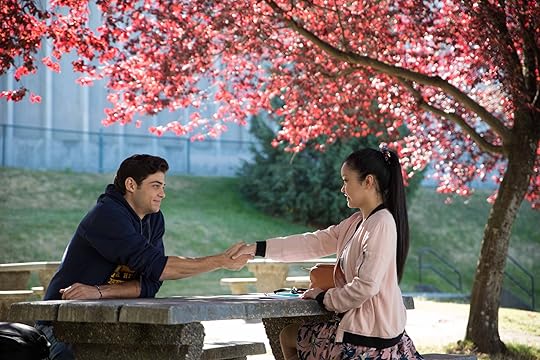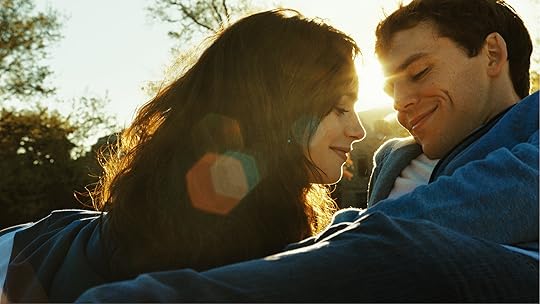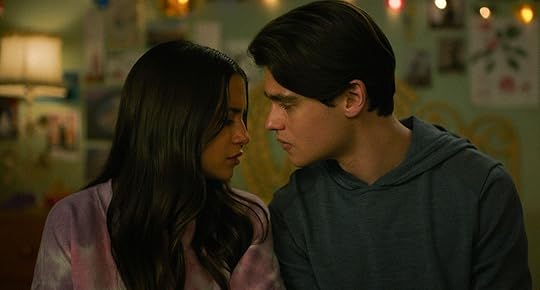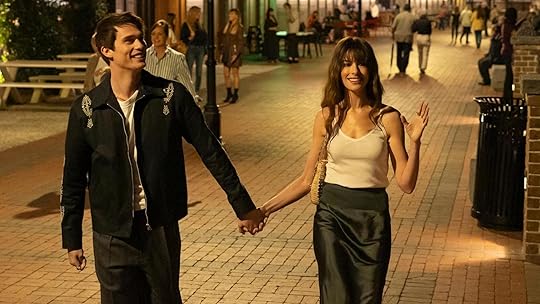7 Rom-Com Adaptations We Love.
Romantic comedies ruled the ’80s and ’90s. Meg Ryan and Tom Hanks practically invented the professional meet-cute, Julia Roberts showed us how to fall in love while shopping for books, and Hugh Grant’s floppy hair had more charisma than half of Hollywood combined. That golden age might have faded a little, but let’s be honest, our appetite for love stories with a side of laughter isn’t going anywhere.
Rom-coms work because they remind us that falling in love is rarely straightforward, it’s awkward, hilarious, messy, and, when the stars align, magical. And as summer slips away (goodbye rooftop cocktails and whirlwind holiday flings, hello oversized sweaters and pumpkin spice), what better time to look back at how some of the most beloved rom-coms have made the leap from page to screen? Because even if summer romance has packed its bags, the season for cosy re-watches and swoon-worthy stories is eternal.
So grab your popcorn, queue up your streaming service of choice, and let’s dive into seven adaptations that prove true love always plays better with a punchline.
7 Secrets to Craft a Rom-Com That Hooks Every Reader.

#1 – Crazy Rich Asians.
Based on Kevin Kwan’s novel.
When Crazy Rich Asians landed in cinemas, it felt like stepping into a modern-day fairytale, if fairytales involved private jets, couture gowns, and a wedding so extravagant it made everyone rethink their budget for floral arrangements.
Rachel (Constance Wu) and Nick (Henry Golding) might look like your standard rom-com couple: smart, independent woman meets charming, secretly loaded man, but throw in a disapproving mother-in-law, a houseful of snarky cousins, and Singapore’s most lavish parties, and you’ve got yourself rom-com nirvana.
Why it works: The genius of Crazy Rich Asians is that it doesn’t just dazzle with glamour; it grounds all that spectacle in real emotional conflict. Sure, the “wedding of the century” scene is jaw-dropping, but it’s the quiet mahjong match between Rachel and Nick’s formidable mother, Eleanor (Michelle Yeoh), that delivers the emotional punch. Comedy flows naturally from supporting players like Awkwafina’s Peik Lin, but it never distracts from the central romance; it highlights it.
The rom-com element it nails: Conflict. A romance without obstacles is just… nice. And nice doesn’t make for great cinema. Here, the hurdles aren’t random; they come from cultural traditions, generational expectations, and questions of identity.
Lesson for writers: Supporting characters and cultural context aren’t just background, they’re fuel. Use them to raise the stakes, add humour, and deepen the love story. A rom-com world should feel as alive and complicated as real love itself.
 #2 – To All the Boys I’ve Loved Before.
#2 – To All the Boys I’ve Loved Before.
Based on Jenny Han’s YA novel.
Accidentally mailing all your secret love letters? Nightmare fuel. For Lara Jean Covey (Lana Condor), it’s the start of one of Netflix’s most delightful rom-coms.
Enter Peter Kavinsky (Noah Centineo), her fake boyfriend who quickly becomes very real, very swoon-worthy, and the internet’s collective crush for at least three years running.
Why it works: The fake-dating trope is one of rom-com’s most beloved setups, but this adaptation nails it by making the characters feel authentic. Lara Jean is shy, dreamy, and relatable; Peter is confident yet unexpectedly soft. Their dynamic feels fresh, even though the trope itself is familiar. The comedy comes from the awkwardness of being 16 and trying to control feelings you can’t, while the heart comes from watching two teens surprise themselves with real love.
The rom-com element it nails: Chemistry. Every look, every pause, every hand slipped casually into a back pocket (you know the one) makes us believe these two belong together.
Lesson for writers: Tropes aren’t clichés if you infuse them with specificity. Chemistry doesn’t come from plot devices; it comes from how your characters see and change each other. Details matter.
[image error]
#3 – This Time Next Year.
Based on Sophie Cousens’ novel.
Minnie (Sophie Cookson) and Quinn (Lucien Laviscount) were born just minutes apart on New Year’s Day, which basically screams destiny, but fate decides to toy with them first.
Sophie Cousens adapted her own novel for the screen, which means the movie stays true to its delicious mix of missed chances, serendipity, and laugh-out-loud moments.
Why it works: This is a story built on timing, on the frustrating, funny, and sometimes magical ways life keeps people apart until they’re ready to be together. Minnie and Quinn come from totally different worlds, and their collisions are full of humour, but also filled with that irresistible question: what if? By the time they finally connect, the audience has been strung along in the best way possible.
The rom-com element it nails: Timing. The “will-they/won’t-they” rhythm is central to rom-coms, and this film leans into it with confidence. Every near miss makes the resolution more satisfying.
Lesson for writers: Don’t give away the happy ending too soon. Tension is the engine of romance. Carefully placed obstacles, be it bad timing, self-doubt, or outside forces, make the final payoff feel earned.

#4 – Love, Rosie.
Based on Cecelia Ahern’s Where Rainbows End*
Rosie (Lily Collins) and Alex (Sam Claflin) are childhood best friends who are clearly meant to be together; everyone sees it but them.
Unfortunately, life keeps pulling them in different directions: missed opportunities, bad timing, and more than one awkward wedding toast later, we’re all sitting at home silently screaming, “Just kiss already!”
Why it works: The story captures the heartbreak and beauty of almost-love. Rosie’s setbacks are sometimes funny, sometimes frustrating, but always relatable. The humour in her misadventures keeps the story from tipping into pure tragedy, and the slow-burn romance makes every “almost” feel meaningful.
The rom-com element it nails: Longing. Some love stories burn fast; this one simmers for decades. It’s a masterclass in keeping audiences invested without losing them to frustration.
Lesson for writers: Long timelines require precision. Each near miss should deepen the connection rather than stall it. And sprinkling in humour ensures the audience roots for the couple, not against them.

#5 – Me Before You.
Based on Jojo Moyes’ novel
Louisa Clark (Emilia Clarke) is all quirky outfits and sunshine; Will Traynor (Sam Claflin) is broody and bitter after an accident changes his life.
Their relationship starts with sarcasm and side-eye, then slowly turns into something transformative. And yes, tissues are mandatory.
Why it works: Though it veers more toward drama, the rom-com DNA is strong. Lou’s relentless optimism and Will’s dry wit create some of the best banter in recent memory. The humour adds levity to the film’s heavier themes, making the love story feel both tender and real.
The rom-com element it nails: Banter. Quick, witty dialogue is the lifeblood of rom-coms. Lou and Will prove that laughter can bridge even the widest emotional gaps.
Lesson for writers: Don’t fear mixing tones. Humour doesn’t cheapen serious stories; it amplifies them. Let levity give your audience space to breathe so the emotional moments land harder.
 #6 – Turtles All the Way Down.
#6 – Turtles All the Way Down.
Based on John Green’s novel
Aza Holmes (Isabela Merced) is a teenager living with OCD who reconnects with her childhood crush, Davis (Felix Mallard). Their romance is messy, tender, and at times awkwardly funny, just like real first love.
Why it works: This isn’t a glossy rom-com filled with grand gestures; it’s quiet and authentic. The humour comes in small doses, moments of levity between Aza’s spirals, that remind us romance doesn’t have to be perfect to be meaningful.
The rom-com element it nails: Authenticity. The film leans into imperfections, showing that love can exist alongside struggle. The laughs may be softer, but they’re no less important.
Lesson for writers: Realness resonates. Don’t be afraid to let your characters be vulnerable, flawed, or messy. Comedy can come from honesty as much as from hijinks.
 #7 – The Idea of You.
#7 – The Idea of You.
Based on Robinne Lee’s novel.
Anne Hathaway as Solène, a sophisticated 40-year-old single mom, falling for Hayes (Nicholas Galitzine), a much younger boy band star?
On paper, it sounds like pure tabloid fodder. On screen, it’s surprisingly smart, funny, and deeply romantic.
Why it works: This film could’ve leaned on clichés but instead grounds itself in emotional truth. Hathaway plays Solène with warmth and wit, while Galitzine’s Hayes feels both magnetic and vulnerable. The comedy comes from the absurdity of their worlds colliding, but the story digs deeper into themes of agency, desire, and societal judgment.
The rom-com element it nails: Breaking expectations. By centring a mature heroine and exploring an unconventional age-gap romance, the film pushes the rom-com into new, refreshing territory.
Lesson for writers: Don’t box yourself in. Rom-coms don’t have to be about twentysomethings meeting cute in coffee shops. Bold premises and layered conflicts can breathe new life into a familiar genre.
From the glittering spectacle of Crazy Rich Asians to the slow-burn ache of Love, Rosie, and the raw honesty of Turtles All the Way Down, these adaptations prove rom-coms aren’t one-size-fits-all. They can be big or small, silly or serious, sweet or bittersweet. What matters is that they make us laugh, make us care, and remind us that love is as complicated as it is joyful.
For writers, the lessons are clear:
Embrace tropes, but twist them.Let humour soften heartbreak.Make supporting characters earn their place.Play with timing to build tension. And don’t shy away from authenticity or depth.Because at the end of the day, love is awkward, unpredictable, and often ridiculous, and that’s precisely why we’ll always want to watch two people fumble their way toward it, whether on the page or the screen.
Now it’s YOUR turn – Which rom-com adaptation is your favourite?
Would love to get your input in the comment box below.
The post 7 Rom-Com Adaptations We Love. appeared first on Vered Neta.



